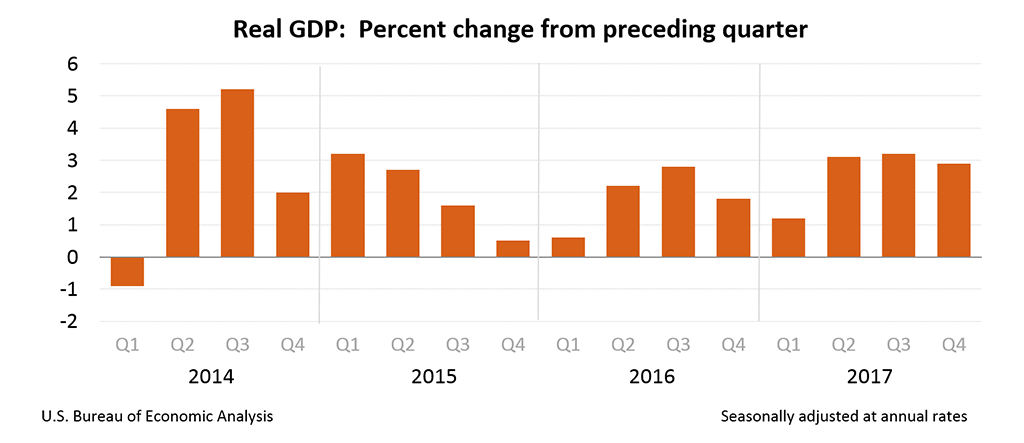Washington, DC…Real gross domestic product (GDP) increased at an annual rate of 2.9 percent in the fourth quarter of 2017 (table 1), according to the “third” estimate released by the Bureau of Economic Analysis. In the
third quarter, real GDP increased 3.2 percent. The GDP estimate released today is based on more complete source data than were available for the “second” estimate issued last month. In the second estimate, the increase in real GDP was 2.5 percent. With this third estimate for the fourth quarter, the general picture of economic growth remains the same; personal consumption expenditures (PCE) and private inventory investment were revised up (see
“Updates to GDP” on page 2).
Real GDP: Percent Change from Preceding Quarter
Real gross domestic income (GDI) increased 0.9 percent in the fourth quarter, compared with an
increase of 2.4 percent in the third. The average of real GDP and real GDI, a supplemental measure of
U.S. economic activity that equally weights GDP and GDI, increased 1.9 percent in the fourth quarter,
compared with an increase of 2.8 percent in the third quarter (table 1).
The increase in real GDP in the fourth quarter primarily reflected positive contributions from PCE,
nonresidential fixed investment, exports, residential fixed investment, state and local government
spending, and federal government spending that were partly offset by a negative contribution from
private inventory investment. Imports, which are a subtraction in the calculation of GDP, increased
(table 2).
The deceleration in real GDP growth in the fourth quarter reflected a downturn in private inventory
investment that was partly offset by accelerations in PCE, exports, state and local government spending,
nonresidential fixed investment, and federal government spending, and an upturn in residential fixed
investment. Imports, which are a subtraction in the calculation of GDP, turned up.
Current-dollar GDP increased 5.3 percent, or $253.5 billion, in the fourth quarter to a level of $19,754.1
billion. In the third quarter, current-dollar GDP increased 5.3 percent, or $250.6 billion (table 1 and table
3).
The price index for gross domestic purchases increased 2.5 percent in the fourth quarter, compared
with an increase of 1.7 percent in the third quarter (table 4). The PCE price index increased 2.7 percent,
compared with an increase of 1.5 percent. Excluding food and energy prices, the PCE price index
increased 1.9 percent, compared with an increase of 1.3 percent (appendix table A).
Updates to GDP
The upward revision to the percent change in real GDP reflected upward revisions to PCE and private
inventory investment. For more information, see the Technical Note. A detailed “Key Source Data and
Assumptions” file is also posted for each release. For information on updates to GDP, see the
“Additional Information” section that follows.
Advance Estimate Second Estimate Third Estimate
(Percent change from preceding quarter)
Real GDP 2.6 2.5 2.9
Current-dollar GDP 5.0 4.9 5.3
Real GDI … … 0.9
Average of Real GDP and Real GDI … … 1.9
Gross domestic purchases price index 2.5 2.5 2.5
PCE price index 2.8 2.7 2.7
2017 GDP
Real GDP increased 2.3 percent in 2017 (that is, from the 2016 annual level to the 2017 annual level),
compared with an increase of 1.5 percent in 2016 (table 1).
The increase in real GDP in 2017 primarily reflected positive contributions from PCE, nonresidential fixed
investment, and exports. These contributions were partly offset by a decline in private inventory
investment. Imports, which are a subtraction in the calculation of GDP, increased (table 2).
The acceleration in real GDP from 2016 to 2017 reflected upturns in nonresidential fixed investment and
in exports and a smaller decrease in private inventory investment. These movements were partly offset
by decelerations in residential fixed investment and in state and local government spending. Imports,
which are a subtraction in the calculation of GDP, accelerated.
Current-dollar GDP increased 4.1 percent, or $766.1 billion, in 2017 to a level of $19,390.6 billion,
compared with an increase of 2.8 percent, or $503.8 billion, in 2016 (table 1 and table 3).
The price index for gross domestic purchases increased 1.8 percent in 2017, compared with an increase
of 1.0 percent in 2016 (table 4). The PCE price index increased 1.7 percent, compared with an increase
of 1.2 percent. Excluding food and energy prices, the PCE price index increased 1.5 percent, compared
with an increase of 1.8 percent (appendix table A).
During 2017 (measured from the fourth quarter of 2016 to the fourth quarter of 2017), real GDP
increased 2.6 percent, compared with an increase of 1.8 percent during 2016. The price index for gross
domestic purchases increased 1.9 percent during 2017, compared with an increase of 1.4 percent during
2016 (table 7).
Corporate Profits (table 12)
Profits from current production (corporate profits with inventory valuation adjustment and capital
consumption adjustment) decreased $1.1 billion in the fourth quarter, in contrast to an increase of
$90.2 billion in the third quarter.
Profits of domestic financial corporations decreased $14.6 billion in the fourth quarter, in contrast to
an increase of $47.8 billion in the third. Profits of domestic nonfinancial corporations increased $19.4
billion, compared with an increase of $10.4 billion. Rest-of-the-world profits decreased $5.9 billion, in
contrast to an increase of $32.0 billion. In the fourth quarter, receipts increased $14.9 billion, and
payments increased $20.8 billion.
In 2017, profits from current production increased $91.2 billion, in contrast to a decrease of $44.0
billion in 2016. Profits of domestic financial corporations increased $15.7 billion, in contrast to a
decrease of $2.0 billion. Profits of domestic nonfinancial corporations increased $37.4 billion, in contrast
to a decrease of $51.7 billion. The rest-of-the-world component of profits increased $38.0 billion,
compared with an increase of $9.8 billion.
The 2017 Tax Cuts and Jobs Act includes several provisions that impact the business income and
personal income statistics in the national income and product accounts (NIPAs). The provisions do not
impact corporate profits for current production or GDI but do impact net cash flow in the fourth quarter
of 2017. For more information, see the Technical Note.



